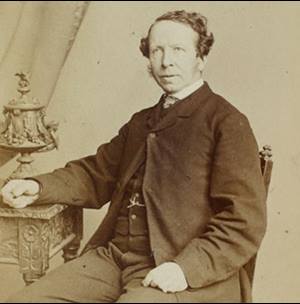Thomas Hawkins (1810-1889)

|
Thomas Hawkins, by Maull & Co, [1865-1877]. Archive ref: GSL/POR/45/01-02.
|
Born in Glastonbury, Somerset, Thomas Hawkins (1810-1889) is best known today for his collection of ichthyosaurs and plesiosaurs which were sold in two parts to the British Museum in 1834 and 1840, and which are now part of the Natural History Museum.
Hawkins apprenticed as a surgeon before entering Guy’s Hospital as a surgeon’s pupil in 1831. It is unclear whether he completed his medical training but by 1832 he was living at Sharpham Park, near Glastonbury, when he began to build up his collection of extinct marine reptiles mainly from the local quarries at Street.
The naturalist Richard Owen (1804-1892) visited the rather eccentric Hawkins in 1839 to view his fossil collection. There he was served peacock eggs for breakfast before an unexpected audience of around fifteen of Hawkins’ disappointed neighbours who thought they had been invited to meet the social reformer and philanthropist Robert Owen.
Hawkins published two major works on his collection - ‘Memoirs of Ichthyosauri and Plesiosauri, extinct monsters of the ancient earth...’ (1834) and ‘The book of the great sea-dragons, Ichthyosauri and Plesiosauri ... gedolim taninim, of Moses...'(1840). Both publications contained large scale lithographic reproductions of the finer specimens from his collection but whilst the former did contain some semblance of anatomical analysis, by the time of the issuing of the latter this had been abandoned to be replaced by incoherent, theological ramblings (some of which were in Hebrew) on the ‘Gedolim Taninim of Moses, extinct monsters of the Ancient Earth'.
As well as being highly eccentric, Hawkins was also argumentative and litigious. For example he threatened to sue the palaeontologist and publisher Edward Charlesworth (1813-1893) for criminal libel over off-the-cuff remarks he had made at a dinner party on the possible underhanded nature of the sale of Hawkins’ collection to the British Museum. Hawkins had been liberal in his use of plaster in ‘restoring’ specimens, a fact which only came to light in the wider academic community during a Select Committee hearing on the Condition, Management and Affairs of the British Museum held in 1835. To escape legal action, Charlesworth fled to Mexico.
Over the years, Hawkins’ eccentricities became more acute with age and by the 1871 census he was describing himself as the ‘Rightful Earl of Kent’.
<<Back to exhibition